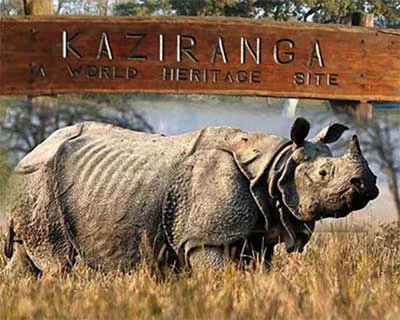Daily Current Affairs for UPSC, IAS, UPPSC/UPPCS, BPSC, MPPSC, RPSC and All State PCS Examinations
National Disaster Response Fund (NDRF)
Why in NEWS?
- Central Government has laid out the modalities for receipt of contributions/ grants from any person or institution for the purpose of disaster management in the National Disaster Response Fund (NDRF) as per Section 46(1) (b) of the Disaster Management (DM) Act, 2005.
About
- Ministry of Home Affairs (MHA) said the contributions to the NDRF have been allowed through any of the modes like physical instruments, Real-Time Gross Settlement (RTGS)/National Electronic Funds Transfer (NEFT)/ Unified Payments Interface (UPI) and https://bharatkosh.gov.in
- These contributions have been allowed as per Section 46(1) (b) of the Disaster Management (DM) Act, 2005.
- The MHA's approval came after clearance from the Union Finance Ministry.

NDRF
- It is a fund managed by the Central Government for meeting the expenses for emergency response, relief and rehabilitation due to any threatening disaster situation or disaster.
- It was renamed from National Calamity Contingency Fund (NCCF) to National Disaster Response Fund (NDRF) with the enactment of the Disaster Management Act in 2005.
- Defined in Section 46 of the Disaster Management Act, 2005 (DM Act).
- Constituted to supplement the funds of the State Disaster Response Funds (SDRF) of the states to facilitate immediate relief in case of calamities of a severe nature.
- NDRF accounts are audited by Comptroller and Auditor General of India (CAG).
- Ministry of Home Affairs (MHA) monitors relief activities by NDRF except for calamities associated with drought, hailstorms, pest attacks and cold wave /frost which are monitored by Department of Agriculture and Cooperation under Ministry of Agriculture (MoA).
Consumer Protection Act, 2019
IN NEWS
- The Central Government has notified that certain provisions under the Consumer Protection Act, 2019 came into force on July 20, 2020.
CHRONOLOGY
- The Parliament passed the Consumer Protection Bill, 2019 on 06.08.2019 to replace the Consumer Protection Act, 1986 ("1986 Act"). The President of India gave its assent to the Consumer Protection Act, 2019 ("2019 Act") on 09.08.2019.
PURPOSE
- The Government instead of bringing an amendment in the 1986 Act, enacted a new Act altogether so as to provide enhanced protection to the consumers taking into consideration the booming e-commerce industry and the modern methods of providing goods and services such as online sales, tele-shopping, direct selling and multi-level marketing in addition to the traditional methods.
NEW ACT-
- The 2019 Act has brought in some major changes and provides for more protection to the consumers in parimateria to the earlier 1986 Act which can be seen from the comprehensive definition provided for the term 'Consumer' and 'Unfair Trade Practice'.
- One of the most significant additions to the 2019 Act is the proposal to establish Central Consumer Protection Authority ("CCPA") so as to regulate, protect and enforce the interest of the consumers and matters related to unfair trade practices.
- The CCPA has been provided with vast powers to inquire, investigate and take action against violations of the 2019 Act.
- Another major introduction in the 2019 Act is the concept of Product Liability which covers within its ambit the product manufacturer, product service provider and product seller, for any claim for compensation.
CONCLUSION
- Conclusively, the Consumer Protection Act, 2019 when compared with the 1986 Act shows that it provides for greater protection of consumer interests taking into consideration the current age of digitization.
- The 2019 Act also deals with the technological advancements in the industry, provides for easier filing of complaints and also imposes strict liability on businesses including endorsers for violating the interest of the consumers.
Assam Flood Affects World Heritage Site Kaziranga National Park
IN NEWS
- As a fresh wave of floods ravages Assam, 85 per cent of the Kaziranga National Park and Tiger Reserve (KNPTR) remains submerged.
ABOUT
- KNPTR was formed in 1908 on the recommendation of Mary Curzon, the park is located on the edge of the Eastern Himalayan biodiversity hotspots – Golaghat and Nagaon district. In the year 1985, the park was declared as a World Heritage Site by UNESCO.
- Along with the iconic Greater one-horned rhinoceros, the park is the breeding ground of elephants, wild water buffalo, and swamp deer.
- Over the time, the tiger population has also increased in Kaziranga, and that’s the reason why Kaziranga was declared as Tiger Reserve in 2006.

WHAT IS THE ROLE OF FLOODS IN KAZIRANGA’S ECOSYSTEM?
- Assam is traditionally flood prone and Kaziranga is sandwiched between the Brahmaputra River and the Karbi Anglong Hills. Among experts there is a consensus that floods are necessary for Kaziranga by virtue of its ecosystem.
- It is a riverine ecosystem, not a solid landmass-based ecosystem.The system won’t survive without water.The entire area of Kaziranga — formed by alluvial deposits from the Brahmaputra and its tributaries.
- The regenerative nature of floods helps replenish Kaziranga’s water bodies and maintain its landscape, a mix of wetlands, grasslands and semi-evergreen deciduous forests.
WHY FLOODS CAN BE PROBLEMATIC?
- Earlier, a big flood would come once in ten years but now, they occur every other year.Animals adapt naturally to floods but when the waters hit a certain level, they gravitate towards safer, higher ground in the Karbi Anglong hills.
- While in the past, Kaziranga and Karbi Anglong were part of the same landscape, the animals now have to cross the bustling National Highway 37 which cuts across the park.
- As a result, animals that venture out of the park, die either under the wheels of speeding vehicles on the highway, or are killed by poachers who take advantage of their vulnerability.
STEPS TAKEN BY GOVERNMENT
- Over the years, another mitigation measure has been artificial highlands built inside the park for wild animals to take refuge in during the flood.
- Moreover, when the floods hit, Section 144 is imposed along NH-37, speed limits are enforced and fines levied. Barricades are also placed to help animals cross over to Karbi Anglong.
Rare Buddha Statue
Why in NEWS?
- A rare life-sized statue of Buddha that was smashed into pieces with a sledgehammer by construction workers in Pakistan's northwest Khyber-Pakhtunkhwa province that was discovered during excavation at an agriculture farm in tehsil Takht Bhai of Mardan district belonged to the Gandhara civilisation.
About
- The statue depicting the death scenario was the oldest of its kind in the world (nearly 1,700 years old).
- Takht Bhai was once part of the Budhist Gandhara kingdom over 1,000 years ago. It is a tourist destination for people from Sri Lanka, Korea and Japan since it was a part of the Gandhara Civilisation.
Gandhara School of Art
- It is the combination of Greco-Roman and Indian ideas along with the influence of other foreign traditions such as from China and Iran resulted in the formation of a distinct style.
- It was closely associated with Mahayana Buddhism and hence the main theme of this art was Lord Buddha and Bodhisattvas. Example-Bamiyan Buddha statues.
- It mostly flourished in the areas of Afghanistan and present North-Western India. The prominent locations were Taxila, Peshawar, Begram and Bamiyan.
- The period around which the Gandhara School of art flourished could be said to be from 1st century BCE to 4th century CE.
Features
- Mostly made up of black stone and stucco.
- The striking feature of Gandhara School of art shows a very realistic and natural depiction of features in perfection.
- The Greco-Roman effect on Gandhara art can be traced through:
- Halo around the head of Lord Buddha
- Drape and style of the garments
- Buddha’s wavy hair
- The forehead lines
- Ornaments
Prelims Practice Question
Q1. Consider the following statement regarding National Disaster Response Fund (NDRF)
1. It is defined in Section 46 of the Disaster Management
Act, 2005 (DM Act).
2. As per Section 46(1) (b) of the Disaster Management (DM) Act, 2005, any
person or institution can contribute for the purpose of disaster management
in the National Disaster Response Fund (NDRF).
3. Ministry of Home Affairs (MHA) monitors all relief activities by NDRF.
Select the correct option
a. 1 and 3 Only
b. 1 and 2 Only
c. 2 and 3 Only
d. 1,2 and 3
Answer: B
Explanation: Ministry of Home Affairs (MHA) monitors relief activities by NDRF except for calamities associated with drought, hailstorms, pest attacks and cold wave /frost which are monitored by Department of Agriculture and Cooperation under Ministry of Agriculture (MoA).
Q2. CONSIDER THE FOLLOWING STATEMENT AND CHOOSE THE CORRECT ONE-
A. Central Consumer Protection Authority (CCPA) is being
constituted under Section 10(1) of The Consumer Protection Act, 2019.
B. The CCPA, introduced in the new Act, aims to protect the rights of the
consumer by cracking down on unfair trade practices, and false and
misleading advertisements that are detrimental to the interests of the
public and consumers
OPTION
1. A only
2. B only
3. Both
4. None of the above.
Answer-3
Explanation- NOT REQUIRED.
Q3. CONSIDER THE FOLLOWING STATEMENT AND CHOOSE THE CORRECT ONE-
A. KNPTR was Formed in 1908 .The park is located on the
edge of the Eastern Himalayan biodiversity hotspots – Golaghat and Nagaon
district.
B. In the year 2006, the park was declared as a World Heritage Site by
UNESCO.
OPTION
1. A only
2. B only
3. Both
4. None of the above.
Answer- 1
Explanation- KNPTR was Formed in 1908 on the recommendation of Mary Curzon, the park is located on the edge of the Eastern Himalayan biodiversity hotspots – Golaghat and Nagaon district. In the year 1985, the park was declared as a World Heritage Site by UNESCO. , the tiger population has also increased in Kaziranga, and that’s the reason why Kaziranga was declared as Tiger Reserve in 2006.
Q4. Consider the following statement regarding Gandhara School of Art:
1. It is the combination of Greco-Roman and Indian ideas only.
2. It was closely associated with Hinayana Buddhism.
Select the correct option
a. 1 Only
b. 2 Only
c. Both 1 and 2
d. Neither 1 nor 2
Answer: D
Explanation:
- It is the combination of Greco-Roman and Indian ideas along with the influence of other foreign traditions such as from China and Iran resulted in the formation of a distinct style.
- It was closely associated with Mahayana Buddhism and hence the main theme of this art was Lord Buddha and Bodhisattvas







